dieser beitrag wurde verfasst in: englisch (eng/en)
künstler (in grau: assistent/in): Philip Guston, Reuben Kadish, Jules Langsner
titel: La inquisición (The Struggle against Terrorism / The Struggle against War and Fascism)
jahr: 1934–35
adresse: Museo Michoacano, 2° patio, Centro historico, Morelia, Michoacán, México
+: Mural, 1220 cm high / 100 m2. Covered between the 1940s and 1973.
«The left half of the main wall depict[s] nude workers knocking from a ladder, with splintered beam, lead pipe and spike-studded stick, a colossal figure supposed to represent the Medieval Inquisition. […] In the centre is the broken-necked body of a hanged woman and above her a hooded and villainous priest. The other half of the wall is given over to the Modern Inquisition. Near the floor is the body of an electrocuted man, realistically rigid. Rising through a trap door are two hooded figures representing the Ku Klux Klan and Nazism. In the extreme upper right, Communists with sickle and hammer are rushing to the rescue.» (Time, 1935)
«Which artist was responsible for what sections of the mural remains an open question. In later years, as in Time, both professed not to recall. (After the 1930s, Guston did not acknowledge his participation until Ashton’s 1976 biography.) The upper right figures in Morelia carrying Communist symbols exhibit the more generalized forms characteristic of Kadish, while the deeply shaded, muscular Pieta figure and hurtling man rep-resent Guston’s typical style. A photo of Guston high up on a scaffold next to the hooded priest with dagger and book seems to confirm his responsibility for the Klan-related figures. Oles (“Walls to Paint On,” 343-44) asked Ashton and Francis V. O’Connor for their opinions. Both lean toward Kadish as responsible for structure, technique, and overall design, with Guston the probable primary initiator of specific iconographic concepts, and Iconcur. Nat Goldstein’s death from gangrene when he was in his 20s is recounted in Mayer, Night Studio, 17.
[…] Described by Time as an “itinerant poet,” Jules Langsner took charge of such menial tasks as mixing paint as well as promot-ing the Morelia mural’s story to the press; he would later become a distinguished West Coast curator and art critic.
[…] [The fresco] reveals a remarkably sure determination by idealistic young diaspora Jews to bear witness by inserting their own “postmemory” anxieties into a larger geopolitical matrix. Appropriating the historic Inquisition as catalyst, they orchestrated a pictorial structure imaginatively reflective of apprehensions and insecurities endemic to both Los Angeles and Mexico. Adding what W. E. B. Du Bois termed the “double consciousness” of the outsider, Guston and Kadish adroitly wove firsthand concerns into the global context of increasingly dangerous times. Masked behind a controlled and disquieting ambiguity, their complex moral indictment is nothing short of astonishing in its depth and precocity.» (Landau, 2007)

